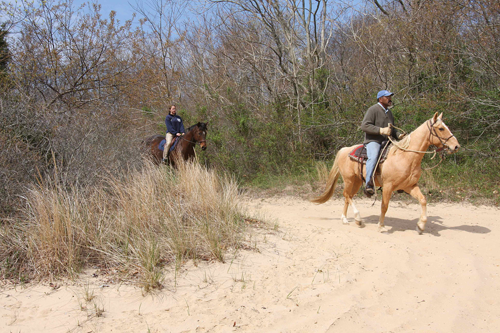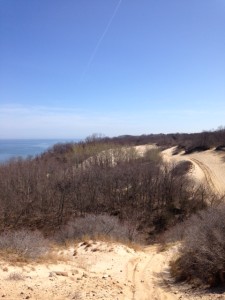NYS: Hallock State Park work to (finally) start this year

Nature buffs who’ve been waiting more than a decade for access to Northville’s Hallock State Park Preserve will soon have their chance — as work to create an access way, visitors center, and trails is scheduled to begin sometime this year, according to a release from Gov. Andrew Cuomo’s office.
Mr. Cuomo announced Tuesday that a total of $90 million in state budget funding had been secured for work at 53 parks and historic sites across the New York State — with $3 million going toward work at the 220-acre preserve.
The news comes some 14 years after the state purchased the park property and an adjoining 300 acres from KeySpan Energy for $16 million in 2002.
It’s also one of a handful of announcements during that time that work would start on the park. Meanwhile, no-trespassing signs had marked trees along the public parks perimeter, keeping it from being utilized, before the News-Review reported on the signs in 2008.

At that time, Senator Ken LaValle (R-Port Jefferson) said he was confident work would start at the park later that year, and two years after he announced the project would be receiving a $1 million grant for an environmental educational center on its grounds.
In the meantime, however, Mr. LaValle said this week that money is no longer available, and had been redirected elsewhere into the state parks system since it was never used.
But his prospects for the park were buoyed by the new allocation of $3 million, which he helped secure.
“I think this is the beginning of opening up a great resource for the people of the East End to enjoy, and people visiting from across the state — because the environmental parts of nature there are very, very special,” he said.
The park property stretches from Sound Avenue to the Sound and includes open plains, a tidal pond, thick woods and a mile-long stretch of pristine beach.
The $3 million comes in addition to $3.9 million that had been raised from the sale of the adjoining 300 acres — which were sold as protected farmland to local farmers, said Dan Keefe, a spokesman for the state Department of Parks, Recreation and HIstoric Preservation.
The newly allotted $3 million and about $900,000 from the farmland sales will be used to construct an entrance route, visitor center, a “green” parking area, and trails to provide public access to undeveloped areas of the park, Mr. Keefe said.
“Right now there is no legal way to access that park,” said Richard Wines, president of the Hallockville Museum Farm that borders the property. “The additional $3 million is great news for the public who will finally have access to enjoy this incredibly beautiful resource.”
Mr. Wines said the current plan, which was developed in 2010, is to put the visitor center close to the Hallockville Museum on Sound Avenue.
Should that be the case, Mr. Wines said the museum stands to benefit greatly, and could possibly share services with the park at some point in the future.
The visitor center will house restrooms and a meeting room to gather for educational events and programs, Mr. Keefe said, adding that a finalized design plan is currently in the works, with construction to begin sometime in 2014.
“We have been waiting for years now for things to get going so the public would have assess,” said Joseph Gergela, executive director of the Long Island Farm Bureau, which helped facilitate the sale of the protected farmland to raise funding for the park’s development. “It’s a beautiful piece of property. It was a major accomplishment for all of us that were involved in it.”
Many players took park in the conservation — and now the much-anticipated development plan for the park — a close to 50-year process that, were the land not protected, it could have been transformed to fit any number of different development projects, including nuclear power plants, said Herb Strobel, executive director of the Hallockville Farm Museum.
“Very few residents have any idea of what the land might have [otherwise] been,” Mr. Strobel said. “It could have been a major industrial seaport… [or a] site for several nuclear plants— but it is not. It could have been the site for major residential development—but it is not.”
“Each of these scenarios would have dramatically changed Riverhead, the entire North Fork, and probably the whole East End,” he said.
Long Island State Parks Commission member and Hallockville Museum Farm director, George Bartunek, said the pairing of the state park with the closeby Hallockville Museum and the Long Island Antique Power Association “creates a grouping of attractions on Sound Avenue that will reflect the connection between Long Island’s natural history and its agricultural heritage.”
See below for more information.
View Larger Map
Trails, starting from the visitors center, will lead north to the property’s sandy beaches, though there will be no actual beach usage permitted initially, Mr. LaValle said.
“This is the first step,” Mr. LaValle said. “That park, in terms of the future, will have a mirage of different uses. I think given the economy it’s always good that people have local options that they can do with their family.”
Funding has also been set aside for other local state parks, it was announced this week.
Orient State Park will also be receiving $200,000 to replace a failing drinking water line for a health and safety reasons, while Wildwood State Park will be receive unspecified funding for upgrades to non-compliant cesspools.
“As we celebrate Earth Day, we continue to invest in our parks and historic sites statewide,” Mr. Cuomo said in a statement. “New York is proud to have the nation’s oldest State park system, and we will continue to do all that we can to preserve and guard these natural resources so that they can be enjoyed for generations to come.”
According to Mr. Cuomo, a recent study by Parks & Trails New York found that state parks generate $1.9 billion in economic activity annually and support 20,000 jobs statewide.
[email protected] Follow @carriemiller01








